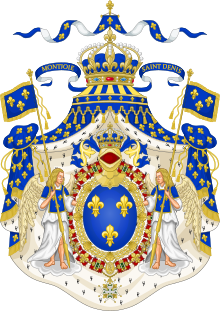Montjoie Saint Denis!
Montjoie Saint Denis! (French pronunciation: [mɔ̃tʒwa sɛ̃ d(ə).nis]) was the battle cry and motto of the Kingdom of France (including the Bourbon Restoration).

It allegedly referred to Charlemagne's legendary banner the Oriflamme, which was also known as the "Montjoie" (Old French: Munjoie) and was kept at the Abbey of Saint Denis, ultimately in reference to Saint Dionysius, though alternative explanations exist (see below).
The battle cry was first used during the reign of Louis VI of France (r. 1108–1137), the first royal bearer of the Oriflamme.[1]
Etymology of "Montjoie"
The etymology of the term "Montjoie" is uncertain and debated, with three main hypotheses for its origin. It is first recorded in The Song of Roland (12th century). The Catholic Encyclopedia suggested it originated in a term for marking stones or cairns set up on the roadside, in Late Latin known as mons Jovis ("mountain of Jove"), which from c. 1200 in Middle French appears as monjoie.[2] According to the Encyclopedia, cairns were used by warriors as gathering places and was applied to the Oriflamme, by analogy in that it guided warriors into combat like they would meet by said cairns.
Alternative hypotheses
"Montjoie" has also been proposed as being derived from a Germanic source, *mund gawi ("pile of stones"), supposedly used as a battle cry in a sense of "hold the line!". It has alternatively been proposed as deriving from *mund galga, from mund ("protect") and galga ("cross, rood", as pilgrims would often affix crucifixes to these stones).[3][4] Charles Arnould claimed the word originated in Gaulish *mant- ("path") and gauda ("pile of stones").[5]
References
- "CATHOLIC ENCYCLOPEDIA: Oriflamme". www.newadvent.org.
- Larousse, Éditions. "Définitions : montjoie - Dictionnaire de français Larousse". www.larousse.fr.
- Joseph J. Duggan, A Guide to Studies on the Chanson de Roland, DS Brewer, 1976, pp. 53f.
- Saint-Allais 1816: Ce qu'on a de plus sensé sur cette matière se réduit à remarquer qu'on appelait autrefois Mont-Joye un monceau de pierres entassées pour marquer les chemins ; sur quoi le Cardinal Huguet de Saint-Cher rapporte la coutume des pèlerins, qui faisaient des Mont-Joyes de monceaux de pierres sur lesquels ils plantaient des croix aussitôt qu'ils découvraient le lieu de dévotion où ils allaient en pèlerinage [...] Or, comme ces Mont-Joyes étaient destinés à marquer les chemins, de même, quand nos rois eurent pris Saint-Denis pour protecteur du royaume, et sa bannière ou l'oriflamme pour bannière de dévotion dans les armées, cette bannière devint le Mont-Joye qui réglait la marche de l'armée [...] Il est bon aussi d'observer que ce cri de guerre n'a été introduit dans nos armées que vers le règne de Louis-le-Gros, qui, ayant réuni en sa personne le comté de Vexin à la couronne, devint avoué de l'église de Saint-Denis, en prit la bannière, de laquelle est venu le cri d'armes.
- Duggan, Op. cit.